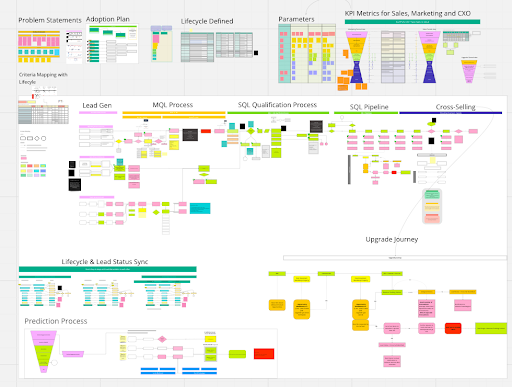
Lack of Processes

Bad Data
- Lack of Process: There was no coherent process across their revenue teams. This resulted in a lack of visibility into marketing efforts, a fundamental absence of opportunity management, and an unclear process for customer onboarding.
- Bad Data: The data within their CRM system, HubSpot, was unorganized and uninterpretable, making it nearly impossible to build meaningful reports to gauge marketing and sales performance on a month-on-month or quarter-on-quarter basis.
Our Approach
We initiated our intervention with a three-week discovery workshop involving the company's regional sales teams, their current Chief Marketing Officer (CMO), and the customer onboarding & success teams. The aim was to:
- Create a visual map representing the entire customer journey across various interactions and motions.
- Develop a clear data model highlighting critical business metrics such as transaction volume, license status, sub-industry, payment corridors, and more.
- Enrich and clean the existing database to ensure clear visibility into the sales funnel and customer lifecycle stages.
Here’s a glimpse of the visual map we created for them:

The Solution
Our solutions were multifaceted, focusing on addressing both identified problems comprehensively:
Creating the right Data Model
- We utilized Miro to blueprint the entire customer journey, defining the data model, customer pathways, and essential processes within HubSpot.
- After cleaning the existing database, we:
- Enriched the database with the usual firmographic data, and then the critical data points to finally have a clear view on the database.
- In the resultant database, we then marked contacts against the right lifecycle stages, lead statuses and lead scores; whose definitions were set earlier during the discovery workshops with the client.
Setting up Marketing Journeys
- Marketing was primarily getting contacts from organic efforts i.e. publishing content, that led people to the "contact us" section. Apart from this, they were heavy on offline events and webinars.
- What was missing:
- No follow-through process on contacts that came via "contact us"
- No gated content/value proposition to progressively profile leads so that they become ready enough to be given to sales.
Based on this information:
We defined critical marketing journeys for contacts that:
- Came through existing "contact us", "download PDF", contacts that came through events who didn’t book a meeting with the sales team.
- Were existing ICP fits that visited webpages recently, existing ICP fits that we never touched, and more to progressively profile these leads into MQLs.
We also improved the MQL>>SQL acceptance rate by introducing a property – "Feedback to Marketing”– to refine the data model further, generating better MQLs.
Revenue Measurement Integration
We integrated Apache, a revenue measurement tool, with HubSpot, to enhance visibility into closed-won revenue and facilitate cross-sell opportunities.
Customer Health Analysis
We analyzed the data stored on their Apache server to create a matrix of existing customers. We incorporated the “number of transactions” data with the “closed-won” customer deals in HubSpot. Utilizing this transaction data, we ranked customers based on their health metric; categorizing them into:
- Good
- Okay
- Risk
This allowed our client to timely notify their sales team about potential cross-selling opportunities–which required closer collaboration for performance enhancement, and which were at risk, necessitating proactive measures to prevent deal decay.
The matrix was then used to route customers to sales and marketing based on defined thresholds.
Managing Closed-won Opportunities
Here is a breakdown of how we managed their closed-won opportunities:
- Assessment: We carefully evaluated the integration between the financing system and HubSpot CRM to understand the existing challenges and bottlenecks.
- The technical solution:
- First, we mapped out a process on Miro and integrated a custom API to enable real-time sync between the financing system (Apache) and HubSpot CRM using Apache Superset.
- This API integration powered real-time revenue reporting and analysis dashboards for the finance team.
- Further, we set webhooks for automated triggers, ensuring timely updates and notifications. For instance, a notification to be sent to the implementation team when the first phase of payment is done.
But there’s more
Even still, we were only halfway there.
The next big step was to streamline the marketing team's upgrade journey process and Deal Pipelines at Late Stage Opportunity (LSO) and Early Stage Opportunity (ESO) stages.
The real magic happened by setting precise metrics and playbook defining upgrade journey.
The Impact and Outcomes
The solutions implemented had a significant and measurable impact on the fintech company's operations:
150% increase in Lead to MQL Conversion Rate
20% growth in sales pipeline
15% increase in Customer Lifetime Value
- Enhanced Visibility and Process Efficiency: The establishment of a visual customer journey and a clear data model improved process efficiency across marketing and sales teams.
- Improved Lead Qualification: By implementing key marketing journeys, we managed to increase the Lead to MQL conversion rate by 150%.
- Increased Sales Pipeline and Revenue Growth: The Apache integration efforts and improved lead qualification processes resulted in a 20% growth in the sales pipeline and notable increases in revenue.
- Strategic Cross-Selling: The implementation of automated notifications and clear metrics for customer upgrades led to a 15% increase in Customer Lifetime Value through effective cross-selling strategies – and reduced opportunity cost by saving up to 15 days in the process and activated cross-selling journeys through timely marketing alerts–all automated.


